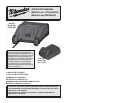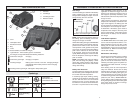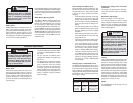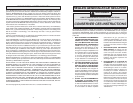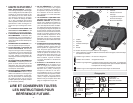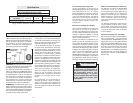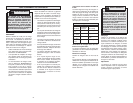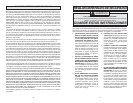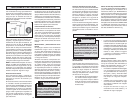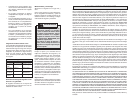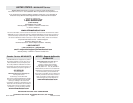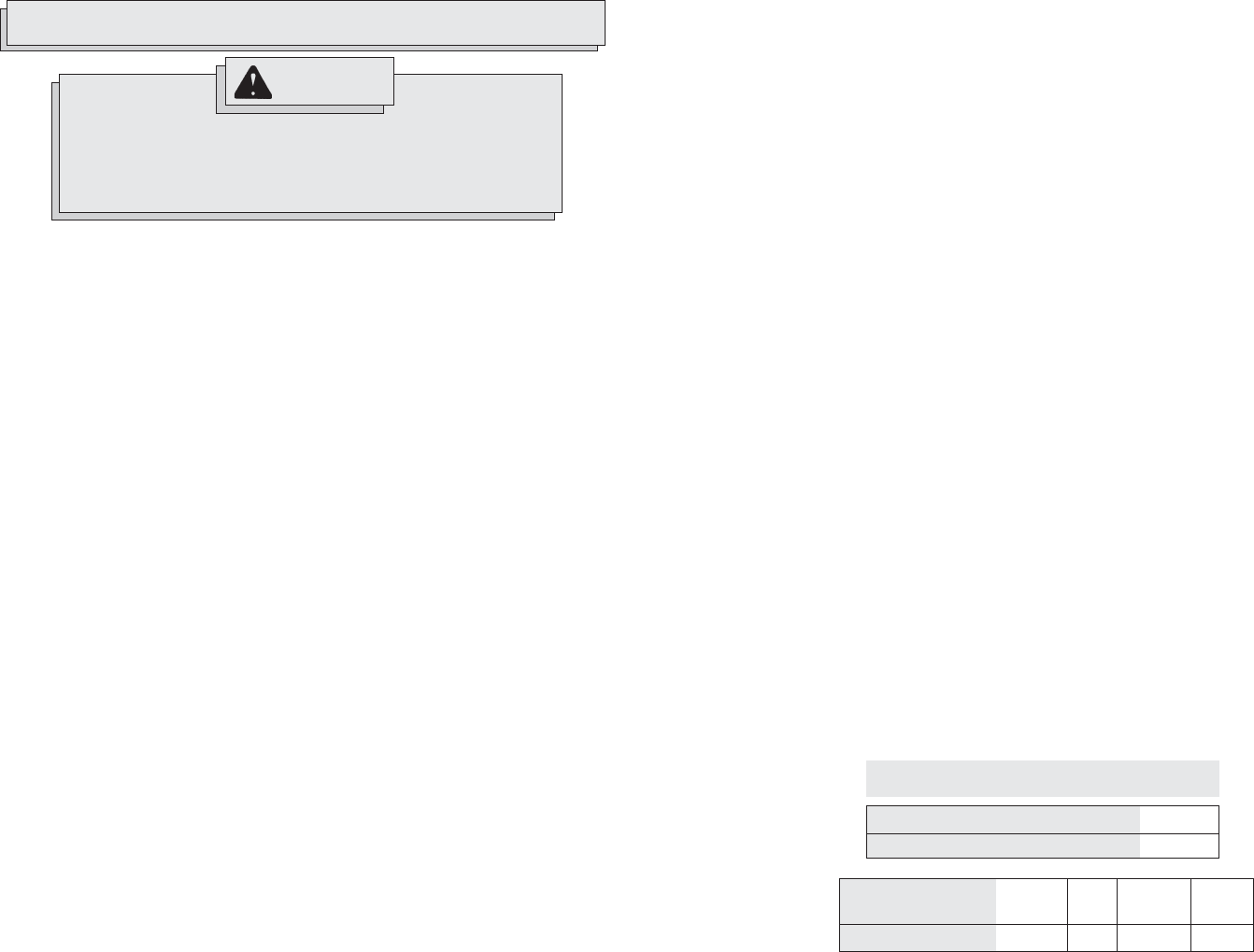
2 3
GENERAL SAFETY RULES
5. MAINTAIN CHARGER CORD. When
unplugging charger, pull plug rather
than cord to reduce the risk of damage
to the electrical plug and cord. Never
carry charger by its cord. Keep cord
from heat, oil and sharp edges. Make
sure cord will not be stepped on, tripped
over or subjected to damage or stress.
Do not use charger with damaged cord
or plug. Have a damaged cord replaced
immediately with identical replacement
parts (see “Maintenance”).
6. DO NOT USE AN EXTENSION CORD
UNLESS IT IS ABSOLUTELY NECES-
SARY. Using the wrong, damaged or
improperly wired extension cord could
result in the risk of fi re and electrical
shock. If an extension cord must be used,
plug the charger into a properly wired
16 gauge or larger extension cord with
pins that are the same number, size and
shape as the pins on the charger. Make
sure that the extension cord is in good
electrical condition.
7. CHARGER IS RATED FOR 120 VOLT
AC ONLY. Charger must be plugged into
an appropriate receptacle.
8. USE ONLY RECOMMENDED AT-
TACHMENTS. Use of an attachment
not recommended or sold by the battery
charger or battery pack manufacturer
may result in a risk of fi re, electric shock
or personal injury.
9. UNPLUG CHARGER when not in use.
Remove battery packs from unplugged
chargers.
This operator's manual contains important safety and operating instructions for MILWAUKEE
Li-Ion battery packs and the MILWAUKEE Li-Ion charger. Before using the battery pack and
charger, read this operator's manual, your tool operator's manual, and all labels on the battery
pack, charger and tool.
WARNING
READ AND UNDERSTAND ALL INSTRUCTIONS.
Failure to follow all instructions listed below, may result in electric shock,
fi re and/or serious personal injury.
SAVE THESE INSTRUCTIONS
1. CAUTION! TO REDUCE THE RISK
OF INJURY, CHARGE MILWAUKEE
LITHIUM-ION PACKS ONLY IN THEIR
MILWAUKEE LITHIUM-ION CHAR-
GER. Other types of chargers may cause
personal injury or damage. Battery pack
and charger are not compatible with V™-
technology or NiCd systems. Do not wire
a battery pack to a power supply plug or
car cigarette lighter. Battery packs will be
permanently disabled or damaged.
2. USE MILWAUKEE LITHIUM-ION
PACKS ONLY ON COMPATIBLE
MILWAUKEE LITHIUM-ION TOOLS.
Battery pack and charger are not com-
patible with V™-technology or NiCd
systems. Use with other tools may result
in a risk of fi re, electric shock or personal
injury.
3. AVOID DANGEROUS ENVIRON-
MENTS. Do not charge battery pack in
rain, snow, damp or wet locations. Do
not use battery pack or charger in the
presence of explosive atmospheres
(gaseous fumes, dust or flammable
materials) because sparks may be
generated when inserting or removing
battery pack, possibly causing fi re.
4. CHARGE IN A WELL VENTILATED
AREA. Do not block charger vents. Keep
them clear to allow proper ventilation. Do
not allow smoking or open fl ames near a
charging battery pack. Vented gases may
explode.
READ AND
SAVE ALL
INSTRUCTIONS
FOR FUTURE
REFERENCE.
10. TO REDUCE THE RISK OF ELECTRIC
SHOCK, always unplug charger before
cleaning or maintenance. Use a Ground
Fault Circuit Interrupter (GFCI) to reduce
shock hazards.
11. DO NOT BURN OR INCINERATE
BATTERY PACKS. Battery packs may
explode, causing personal injury or dam-
age. Toxic fumes and materials are cre-
ated when battery packs are burned.
12. DO NOT CRUSH, DROP, OR DAMAGE
battery pack. Do not use a battery pack
or charger that has received a sharp
blow, been dropped, run over, or dam-
aged in any way (e.g., pierced with a
nail, hit with a hammer, stepped on).
13. DO NOT DISASSEMBLE. Incorrect
reassembly may result in the risk of
electric shock, fi re or exposure to battery
chemicals. If it is damaged, take it to a
MILWAUKEE service facility.
14. BATTERY CHEMICALS CAUSE SERI-
OUS BURNS. Never allow contact with
skin, eyes, or mouth. If a damaged bat-
tery pack leaks battery chemicals, use
rubber or neoprene gloves to dispose
of it. If skin is exposed to battery fl uids,
wash with soap and water and rinse with
vinegar. If eyes are exposed to battery
chemicals, immediately fl ush with water
for 20 minutes and seek medical atten-
tion. Remove and dispose of contami-
nated clothing.
15. DO NOT SHORT CIRCUIT. A battery
pack will short circuit if a metal object
makes a connection between the posi-
tive and negative contacts on the battery
pack. Do not place a battery pack near
anything that may cause a short circuit,
such as coins, keys or nails in your
pocket. A short circuited battery pack
may cause fi re and personal injury.
16. STORE YOUR BATTERY PACK AND
CHARGER in a cool, dry place. Do not
store battery pack where temperatures
may exceed 120°F (50°C) such as in
direct sunlight, a vehicle or metal build-
ing during the summer. Charger will
charge the battery when the battery's
internal temperature is between 14°F
(-10°C) and 150°F (65°C). When the
battery temperature is outside that
range, charging will not occur.
Specifi cations
Catalog No.
48-11-1815 1.4 Ah Li-Ion Battery Pack
Volts DC
18
Catalog No.
48-59-1801 Charger *
Input
Volts AC
120
Input
Amps
2.1
Output
Volts DC
18
Output
Amps
3.5
* Charges MILWAUKEE 48-11-1815 Lithium-Ion battery packs.



